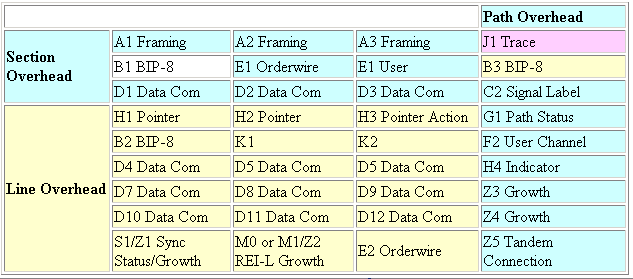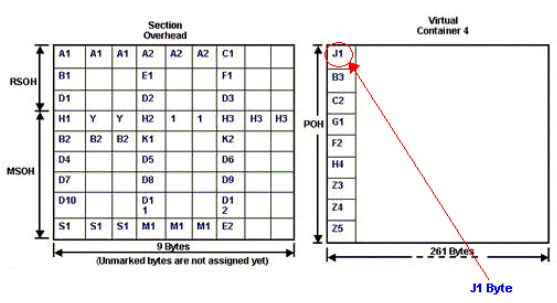Configuring J1 Bytes and Troubleshooting HP-TIM Alarms on POS Line Cards
Available Languages
Contents
Introduction
This document describes how to configure the J1 byte from SDH, High Order Path Overhead (HO-POH) on Packet over SONET/SDH (POS) line cards. This document also explains how to clear HO Path Trace Identifier Mismatch (HP-TIM) alarms.
Prerequisites
Requirements
There are no specific requirements for this document.
Components Used
This document is not restricted to specific software and hardware versions.
Conventions
Refer to Cisco Technical Tips Conventions for more information on document conventions.
The J1 Byte
The Bellcore GR-253 standard defines Synchronous Optical Networks (SONET). SONET uses a layered architecture of Path Overhead (POH), Line Overhead (LOH), and Section Overhead (SOH). The POH column includes the J1 byte, also known as the Path Trace Buffer (PTB).

The G.707 standard of the ITU-T defines the Synchronous Digital Hierarchy (SDH), which is more widely deployed in Europe. G.707 defines the J1 byte as the first byte in the Virtual Container. The associated AU-n (n = 3, 4) or TU-3 pointer indicates the location of this byte. Here is how the standard defines the use of this byte:
"This byte is used to transmit repetitively a Path Access Point Identifier so that a path receiving terminal can verify its continued connection to the intended transmitter. A 16-byte frame is defined for the transmission of an Access Point Identifier. This 16-byte frame is identical to the 16-byte frame defined in 9.2.2.2 for the description of the byte J0. At international boundaries, or at the boundaries between the networks of different operators, the format defined in clause 3/G.831 shall be used unless otherwise mutually agreed by the operators providing the transport. Within a national network or within the domain of a single operator, this Path Access Point Identifier may use a 64-byte frame."
Figure 1 illustrates the position of the J1 byte in the SDH structure:
Figure 1 – The Position of the J1 Byte in the SDH Structure 
Configure the J1 Byte
You can configure these values for the J1 byte:
OSIRS20(config-controller)#overhead j1 ? expected Expected Message length Message length transmit Transmit Message
where:
-
Expected = the string expected from the line. Any mismatch generates an HP-TIM alarm.
-
Length = the length of the string. This could be 16 bytes (SDH) or 64 bytes (SONET).
-
Transmit = the string value that is transmitted into the line.
Here is an example with two POS cards that are directly connected with a dark fibre. This example uses the SDH configuration:
OSIRS20(config-controller)#overhead j1 length 16 OSIRS20(config-controller)#overhead j1 expected expect123456789 OSIRS20(config-controller)#overhead j1 transmit transmit1234567
In this example, the incoming string expected from line is expect123456789, and you transmit the string transmit1234567.
Issue this command in order to see what comes from line:
OSIRS20#show controller sonet 9/1/0
Here is the output:
OSIRS20#show controller sonet 9/1/0
SONET 9/1/0 is up.
Channelized OC-3/STM-1 SMI PA
H/W Version : 24.257.2.3, ROM Version : 1.2
FREEDM version : 2, F/W Version : 1.18.1
Applique type is Channelized Sonet/SDH
Clock Source is Line, AUG mapping is AU4.
Medium info:
Type: SDH, Line Coding: NRZ, Line Type: Short SM
Regenerator Section Status:
No alarms detected.
Multiplex Section Status:
No alarms detected.
No BER failure/degrade detected
BER_SF threshold power : 3
BER_SD threshold power : 6
Higher Order Path Status:
Path# 1 has defects HP-TIM
Captured Trace for Path# 1 is (CRC - 4) transmit1234567
Alternatively, issue this command to capture the last line:
OSIRS20#show controller sonet 9/1/0 | i Captured Trace
As you can see, the HP-TIM alarm is present in the output, because the string expected does not match the string received from far end station. In order to clear the alarm, issue these commands:
OSIRS20(config-controller)#overhead j1 length 16 OSIRS20(config-controller)#overhead j1 expected transmit1234567
Here is the output of these commands:
OSIRS20#show controller sonet 9/1/0
SONET 9/1/0 is up.
Channelized OC-3/STM-1 SMI PA
H/W Version : 24.257.2.3, ROM Version : 1.2
FREEDM version : 2, F/W Version : 1.18.1
Applique type is Channelized Sonet/SDH
Clock Source is Line, AUG mapping is AU4.
Medium info:
Type: SDH, Line Coding: NRZ, Line Type: Short SM
Regenerator Section Status:
No alarms detected.
Multiplex Section Status:
No alarms detected.
No BER failure/degrade detected
BER_SF threshold power : 3
BER_SD threshold power : 6
Higher Order Path Status:
Path# 1 has no defects
Captured Trace for Path# 1 is (CRC - 4) transmit1234567
Additional Options
Another option to clear this alarm is to disable the J1 byte. When you do so, the board no longer reads the information from J1 byte. As a result, the HP-TIM alarm never occurs.
OSIRS20#configure terminal Enter configuration commands, one per line. End with CNTL/Z. OSIRS20(config)#controller sonet 9/1/0 OSIRS20(config-controller)#no over j1 OSIRS20(config-controller)#end
Related Information
Revision History
| Revision | Publish Date | Comments |
|---|---|---|
1.0 |
21-Mar-2005 |
Initial Release |
Contact Cisco
- Open a Support Case

- (Requires a Cisco Service Contract)
 Feedback
Feedback